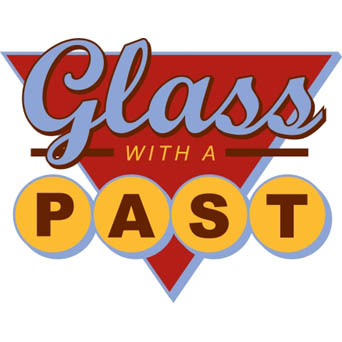Devit on Fused Blue Bottle Glass

Once you start cutting up bottles and fusing them back together, you will notice that blue bottle glass has a tendency to devitrify in a seemingly random way. Take this little star for example. Some of the glass pieces have fairly heavy devit and some have none. If you look closely you can see a batch number etched on one of the glossy strips. This gives us a clue about what may be happening. Batch numbers are always etched on the outside of bottles.
After a ton of testing, I discovered that when the blue glass is fired curved side up, that is, with the INSIDE of the bottle up, it is much more likely to devitrify. I tested with a ton of different blue bottles, as well as other colors. Here’s a selection of the color tests:

The vertical glass on all tests was curved side up, the horizontal piece is curved side down. Although some of the other colors do have a very light devit, the cobalts are all quite frosted. (Click here for a large format zoomable version of this photo)
The easiest way to avoid this is to keep track of which side to fire up. It sounds like it would be a pain, but it does make a huge difference. So, how do you keep track of which side is the inside of the bottle and which is the outside? Here is my secret:
Most bottles have some sort of indent or bump near the bottom from manufacturing, like this:
When you unroll the bottle to make a sheet of glass, this indent will still be there, you can look at it and easily tell which side was out before unrolling (different bottles in these photos, the bump didn’t just change shape!):
And here’s what the indent looks like from the inside of the bottle:
 But what about if you have a bottle without an indent, or have cut pieces out of the sheet? There is an even easier way to keep track. When you put your bottle on the shelf to unroll it, it will look like this:
But what about if you have a bottle without an indent, or have cut pieces out of the sheet? There is an even easier way to keep track. When you put your bottle on the shelf to unroll it, it will look like this:
The inside of the bottle becomes the top surface of the glass sheet and the outside becomes the bottom. After unrolling, the bottom of the sheet, WHICH IS THE OUTSIDE OF THE BOTTLE will have a subtle texture, like this:
And the top of the glass sheet, which was the INSIDE of the bottle will be very shiny, like this:
When you are fusing with blue bottle glass, try to fuse with the shiny side in between layers or towards the shelf to reduce the amount of devitification on your projects. Your stars will thank you!
Related Articles:
Creating Fusible Glass Sheets from Bottles
- Pin and share!
- Requires firing schedule knowledge








